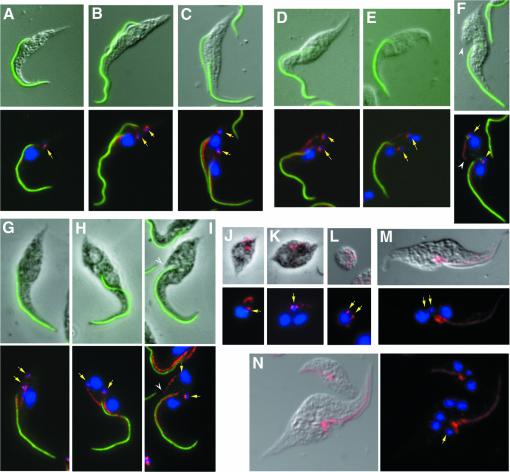Fig. 4. New and old flagella are required for cell morphogenesis. (TbDHC1b) RNAi cells are shown by DIC and (TbIFT88) RNAi cells are shown by phase contrast. Cell cycle of normal, non-induced, (TbDHC1b) RNAi trypanosomes (A–C), of 48-h-induced (TbDHC1b) RNAi (D–F) and (TbIFT88) RNAi (G–I). Flagellum was labelled with L8C4 (green), FAZ filament with L6B3 (red lines), basal body with BBA4 (red spots) and DNA was stained with DAPI (blue). Top panels, DIC merged with flagellum staining (green); bottom image, merged fluorescence. Yellow arrows indicate kinetoplast DNA position. After 48 h of induction, trypanosomes cannot assemble a new flagellum, but nevertheless formation of a short new FAZ (tip indicated by the white arrowhead) is observed. (J and K) Non-flagellated (TbIFT88) RNAi cells (induced for 72 h) stained with the anti-basal body BBA4 and anti-FAZ L6B3 (both in red), and with DAPI (blue). Kinetoplasts segregation failed, even after completion of nuclear mitosis (K). (L) Non-flagellated (TbDHC1b) RNAi cells (induced for 72 h) stained with the anti-basal body BBA4 and anti-FAZ L6B3 (both in red), and with DAPI (blue). Although basal body duplication and segregation occurred, no new FAZ formation was detected. (M and N) After 72 h of induction, flagellated cells were immunolabelled using antibody 1B41 (red) and stained with DAPI (blue), showing lack of assembly of FAZ-associated microtubules, accumulation of patches of material around the basal bodies area and absence of cytokinesis.

An official website of the United States government
Here's how you know
Official websites use .gov
A
.gov website belongs to an official
government organization in the United States.
Secure .gov websites use HTTPS
A lock (
) or https:// means you've safely
connected to the .gov website. Share sensitive
information only on official, secure websites.
